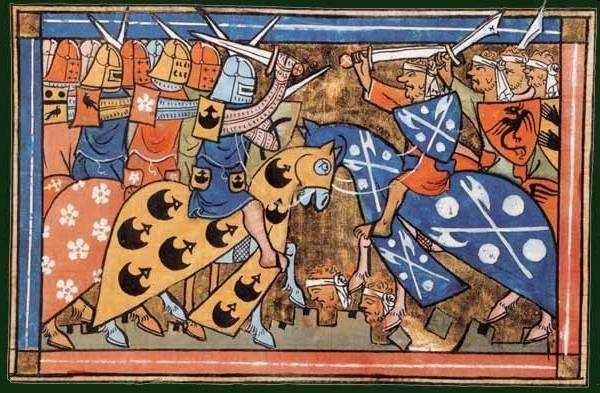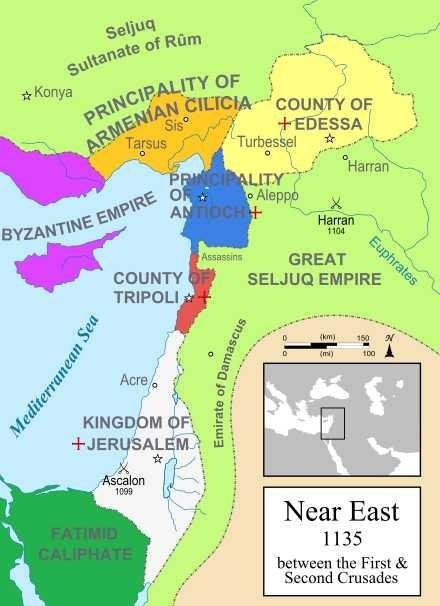
The Crusade (Latin: Expeditio Sacra, English: Crusade) is a series of religious wars endorsed by the Latin Church in the Middle Ages. The most commonly known Crusades are military campaigns in the eastern Mediterranean region that aims to liberate the Holy Land from Islamic colonization, but the term "Crusade" is also used to refer to other Church campaigns endorsed by the Church. The Crusades were fought for a variety of reasons, both to eradicate idolatry and heresy, to settle disputes between equally Catholic and political and territorial gains. When these kinds of wars first flared, there is no such term "Crusade". This term newly surfaced around 1760.
In 1095, Pope Urban II called on the Christian world to wage the First Crusade in his preaching of the Council of Clermont. He urged the audience to provide military aid to the Byzantine Empire and his Emperor, Aleksios I, who needed extra strength in the face of the Turks who had migrated west and colonized Anatolia. One of the goals the Pope wants to achieve is the guarantee of access for pilgrims to sanctuaries in the Muslim-controlled northeast region of the Mediterranean Sea, but scholars disagree as to whether access guarantees to pilgrims are the main motive of the Pope or the main motive of those who respond to his appeal. It may well be that the Pope intends to reunite the Eastern and Western hemispheres of the separate Christian world since the East-West Schism of 1054, and to make himself the head of the united Church. The early victory of the Crusades resulted in the founding of the first four Crusader states in the eastern Mediterranean region of Edessa, the Principality of Antioch, the Kingdom of Jerusalem, and the District of Tripoli. The enthusiastic response to Pope Urban's call from all West European societies set a precedent for the ensuing Crusades. Volunteers became Crusaders by making their vows publicly and receiving a plenary indulgence from the Church. Some hope to be raptured into heaven from Jerusalem or get God's forgiveness for all their sins. Others participate in feudal duty, to gain glory and honor, or to gain economic and political advantage.

The two-century effort to liberate the Holy Land ended in failure. After the First Crusade, there were still six great Crusades and many crucial Crusades. After the last Catholic strongholds were conquered in 1291, there were no more Crusades, but the collected gains lasted longer in northern and western Europe. The Wendi Crusade and Crusade wars inflicted by the Archbishop of Bremen succeeded in unifying the entire northeast region of the Baltic as well as the tribes of Mecklenburg and Lausitz under Catholic control at the end of the 12th century. At the beginning of the 13th century, the Teutonic Order established a Crusader State in Prussia, and the French monarch made use of the Albigensian Crusade to expand his territory to the Mediterranean. The lunge of the Osmanli Empire at the end of the 14th century responded to Catholicism with the Crusade wars that ended with the defeat of Nikopolis in 1396 and in Varna in 1444. Catholic Europe was in a state of chaos, and the last node of Christian-Muslim affinity was marked by two thrilling events: the fall of Constantinople into the hands of the Osmanli Empire in 1453, and Spain's final victory over the Moros by the conquest of Granada in 1492. The idea of the Crusades continued alive, at least in the form of the Order of the Hospitalists, until the end of the 18th century, but the focus of Western European interest has shifted to the New World.
The People's Crusade sparked the killing of thousands of Jews, known as the Rhineland massacre. Constantinople was looted during the Fourth Crusade, so the attempt to reunite the Christian world at that time was impossible. The siege resulted in the weakening of the Byzantine Empire and finally fell into the rule of the Ottoman Empire in 1453. The Western European rulers made no clear response when the last Catholic stronghold of the region, Akko, fell in 1291. [1]
There are various opinions regarding the behavior of crusaders, ranging from the nature of praise to the very critical. The impact of the crusades is enormous; they reopen the Mediterranean Sea for trade and travel, allowing the development of Genoa and Venice. Crusaders trade with locals during their travels, and the Orthodox Roman emperors often organize markets for crusaders moving through their territory. The Crusades combine the common identity of the Latin Church under papal leadership, and are regarded as a symbol of heroism, knighthood, and piety. This therefore gave birth to medieval literature, philosophy, and romance. However the various crusades further solidify the relationship between militarism, feudalism, and Western Catholicism, which is contrary to the Peace and Armistice for God
Downvoting a post can decrease pending rewards and make it less visible. Common reasons:
Submit
DO NOT OPEN THAT LINK. IT IS A PHISHING LINK! HE HACK MY ACCOUNT!
https://steemit.com/introduceyourself/@purepinoy/my-account-has-been-hacked-rip-kiboidesu
Downvoting a post can decrease pending rewards and make it less visible. Common reasons:
Submit